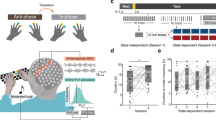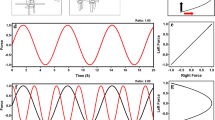Abstract.
The aim of the present study was to investigate whether synchronized activity between the right and left primary sensorimotor cortices has a functional role in the organization of bimanual in-phase and anti-phase movement patterns, performed at different cycling frequencies. To this end we evaluated the cortical dynamics by means of task-related EEG. Both behavioral performance and coupling between the primary sensorimotor cortices in the beta frequency band were reduced with increasing movement speed, and this effect was far more powerful in the anti-phase than in-phase mode. Thus, a progressive degradation of interhemispheric connectivity with cycling rate was associated with a deteriorating behavioral output. Overall, these results support a significant role for interhemispheric synchronization in the control of bimanual movements.
Similar content being viewed by others
Author information
Authors and Affiliations
Additional information
Electronic Publication
Rights and permissions
About this article
Cite this article
Serrien, D.J., Brown, P. The functional role of interhemispheric synchronization in the control of bimanual timing tasks. Exp Brain Res 147, 268–272 (2002). https://doi.org/10.1007/s00221-002-1253-z
Received:
Accepted:
Issue Date:
DOI: https://doi.org/10.1007/s00221-002-1253-z




